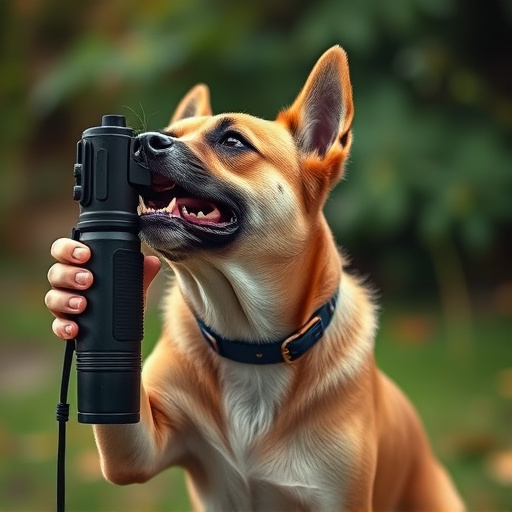Pepper spray formulation against aggressive dogs, featuring capsaicin and enhanced ingredients, offers a swift and effective solution for managing canine behavior. It temporarily disables dogs through heat induction, allowing handlers to regain control and implement training methods. Professional-grade pepper spray equips animal control officers with a powerful, non-lethal tool for de-escalating dangerous situations while adhering to safety guidelines and regulatory compliance.
“Unleashing control with professional-grade pepper spray, a powerful tool in animal control officers’ arsenals, specifically tailored for managing aggressive dogs. This article delves into the intricate world of pepper spray formulations designed for dog control, exploring their composition and effectiveness. We dissect the features and benefits of professional-strength sprays, offering insights into safe usage practices and regulations to ensure optimal results while mitigating risks. Discover how these innovative solutions revolutionize canine management.”
- Understanding Pepper Spray for Dog Control: Its Composition and Effectiveness
- Professional-Grade Pepper Spray: Features and Benefits for Animal Control Officers
- Safe Usage and Regulations: Ensuring Effectiveness and Mitigating Risks When Using Pepper Spray on Dogs
Understanding Pepper Spray for Dog Control: Its Composition and Effectiveness
Pepper spray for dog control has emerged as a popular and effective solution for managing aggressive canine behavior. At its core, this type of spray is designed to temporarily incapacitate or deter dogs through a combination of capsaicin, the chemical compound responsible for the heat sensation in peppers, and other active ingredients. The precise Pepper Spray Formulation Against Aggressive Dogs varies between brands, but it typically includes additives that enhance penetration, duration, and safety for both pets and handlers.
The effectiveness of pepper spray lies in its ability to disrupt a dog’s sensory perception and communication pathways, leading to a temporary loss of balance, coordination, and aggression. This disruption is often swift, allowing owners or trainers to gain control of the situation and implement appropriate behavior modification strategies. However, it’s crucial to note that pepper spray should be used as a last resort, when other training methods have proven ineffective, to ensure the safety of all involved.
Professional-Grade Pepper Spray: Features and Benefits for Animal Control Officers
Professional-grade animal control spray, especially those formulated against aggressive dogs, is designed to provide officers with a powerful and effective tool for managing potential threats. This specialized pepper spray goes beyond standard self-defense options, offering a unique blend of capsaicin and other active ingredients that can neutralize an animal’s senses without causing permanent harm. The key lies in its potency; it’s crafted to incapacitate even the most ferocious dogs, giving control officers precious seconds to assess and de-escalate the situation.
These pepper spray formulations are engineered for optimal performance in challenging field conditions. They come equipped with advanced features like strategic nozzle designs that allow for a precise stream, ensuring the spray reaches its target accurately. Additionally, the non-lethal nature of these sprays means officers can safely control and redirect aggressive dogs while minimizing collateral damage. This technology plays a crucial role in keeping both animal control professionals and the public safe during potentially dangerous encounters.
Safe Usage and Regulations: Ensuring Effectiveness and Mitigating Risks When Using Pepper Spray on Dogs
When using professional-strength pepper spray for dog control, it’s paramount to prioritize safety and adhere to regulations. This powerful formulation is designed specifically to address aggressive canine behavior, offering a non-lethal solution for immediate control. However, its potency necessitates caution. Users must wear protective gear, including eye and face protection, to prevent direct contact with the spray, which can cause significant irritation.
Regulatory bodies have established guidelines for responsible usage, emphasizing that pepper spray should be a last resort when all other methods have failed. These guidelines include restrictions on who can possess and deploy such sprays, as well as specific scenarios in which their use is permissible. Understanding and respecting these regulations are crucial to ensure the effectiveness of the spray while mitigating potential risks associated with its deployment.
Professional-grade pepper spray, with its advanced formulation against aggressive dogs, emerges as a valuable tool for animal control officers. Its effectiveness, combined with proper usage and safety regulations, ensures that it can be employed to mitigate risks while controlling canine aggression. By understanding the composition, benefits, and safe handling practices, professionals can leverage this technology to enhance their capabilities in managing potentially dangerous situations involving dogs.
